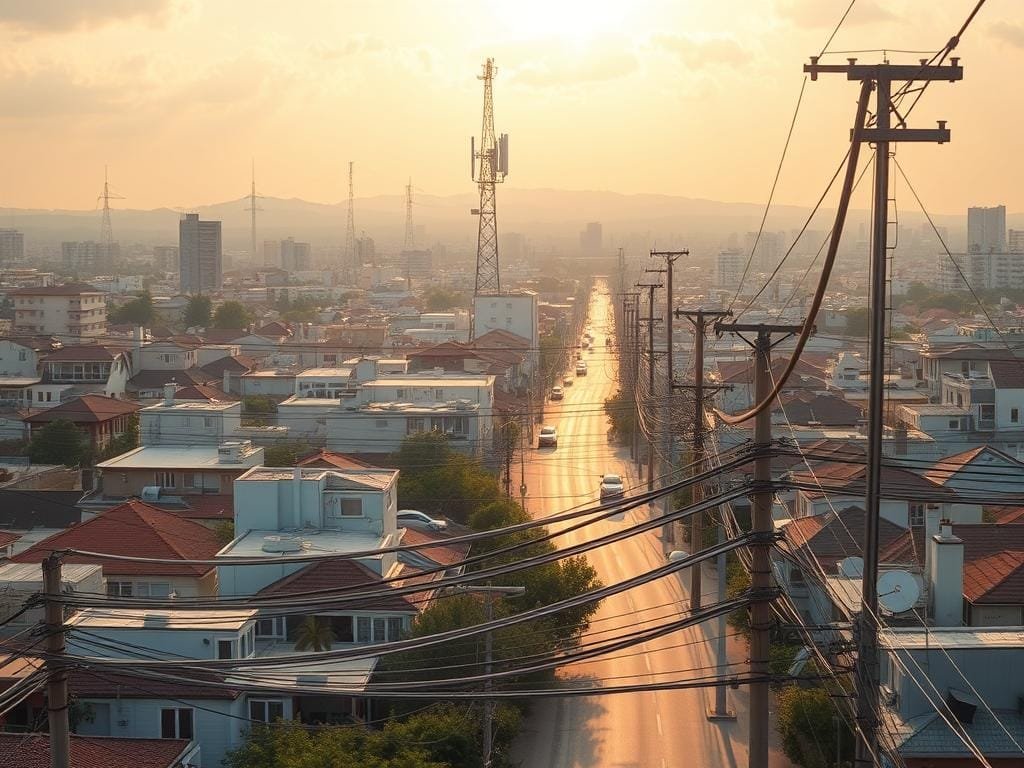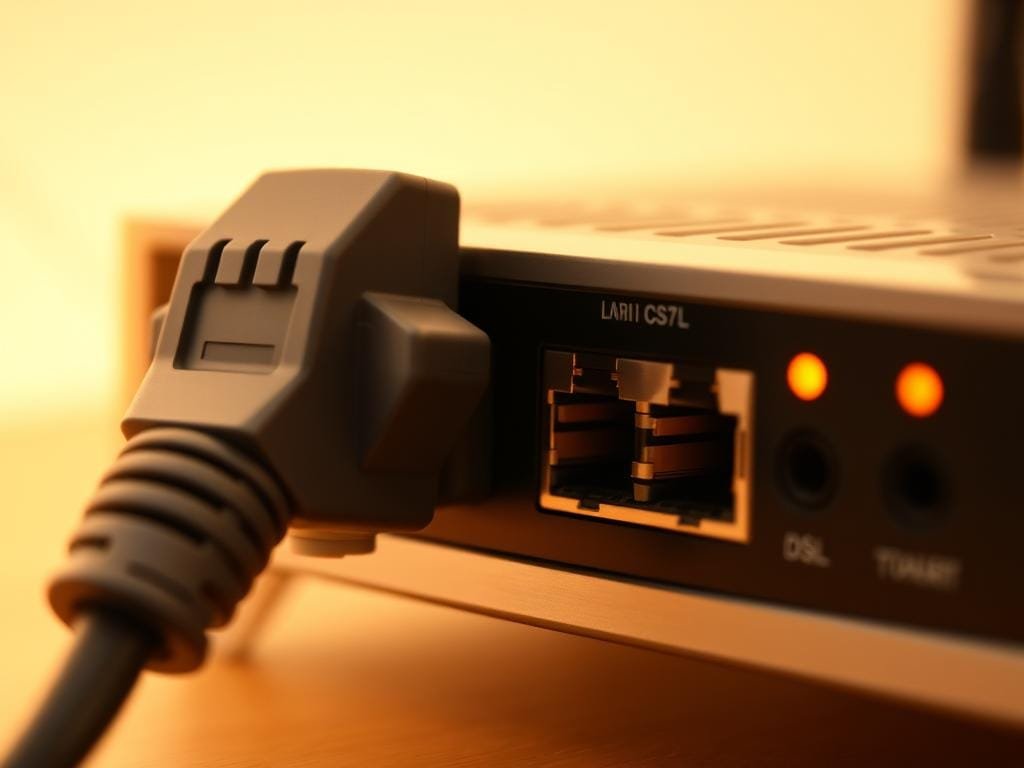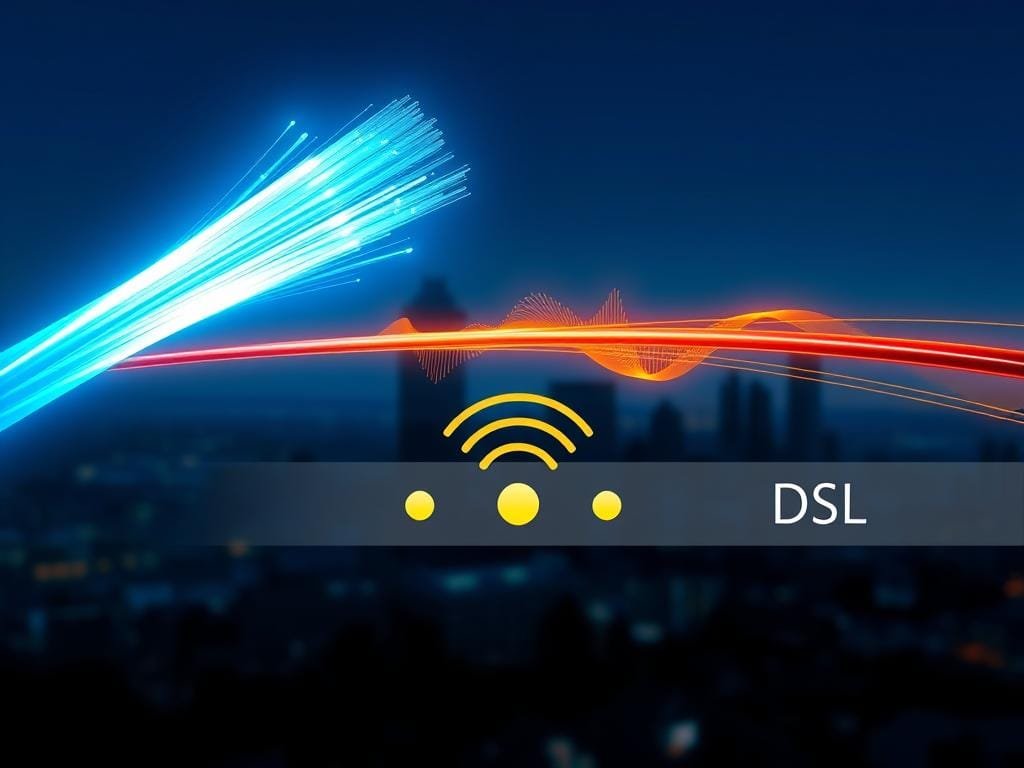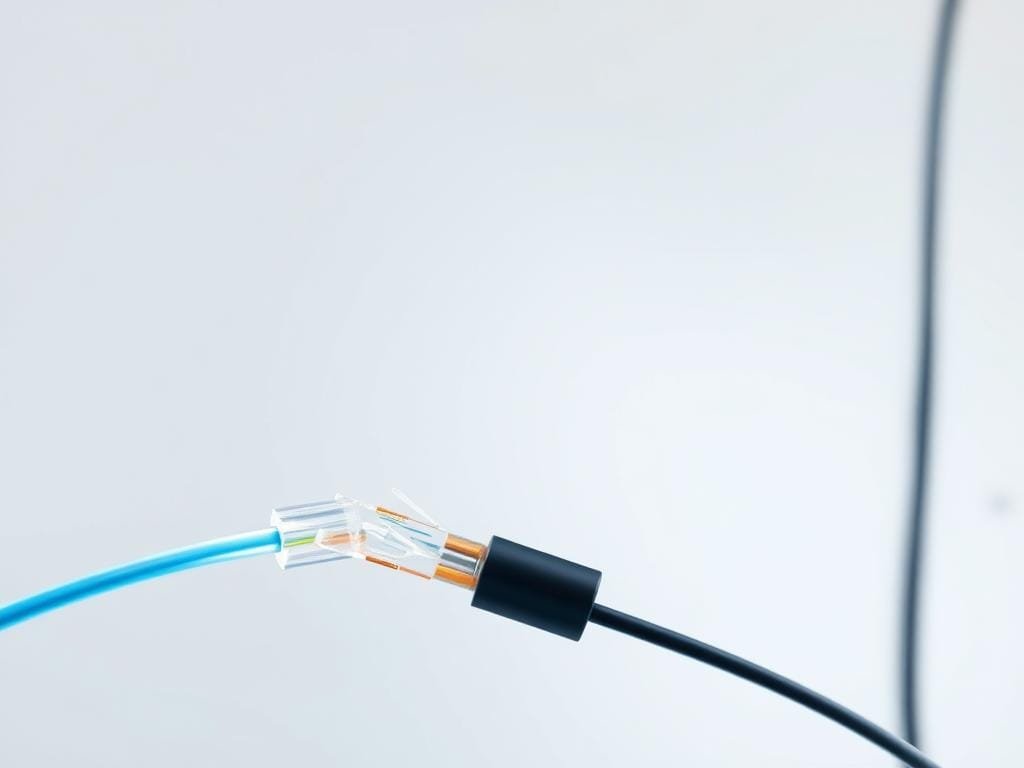Did you know that nearly 48% of US households have access to fiber optic internet? It offers speeds of up to 50 gigabits per second. Choosing the right internet connection type can be tough. It’s important to know the differences between fiber, cable, and DSL.
When picking an internet connection type, consider speed, reliability, and cost. Fiber internet has symmetrical speeds. Cable internet’s upload speeds are usually lower than its download speeds. DSL is more affordable with a flat monthly fee.
Key Takeaways
- Fiber optic internet offers high speeds and reliability.
- Cable internet is widely available but may have variable speeds.
- DSL is a budget-friendly option with consistent pricing.
- Consider your needs: speed, cost, and availability.
- Check the availability of each type in your area.
The Evolution of Home Internet Connections
Home internet connections have changed a lot. They are now faster and more reliable. This change is due to new technology and what people need from the internet.
How Data Travels to Your Home
Data gets to your home through many paths. These include undersea cables, fiber optic lines, and wireless tech. Fiber optic internet uses light in thin fibers for fast, reliable data.
When you ask for a website, your request goes through many steps. It uses different technologies, like cable, DSL, or fiber.
“The infrastructure that supports our internet is vast and complex, involving a mix of old and new technologies.” –
Why Connection Type Matters for Performance
The type of internet you have affects your online life. Each type has its own speed, reliability, and latency. For example, fiber optic connections are usually faster and have less delay than DSL or cable.
| Connection Type | Typical Speed | Reliability |
|---|---|---|
| Fiber | Up to 10 Gbps | High |
| Cable | Up to 1.4 Gbps | Medium |
| DSL | Up to 100 Mbps | Low |
Knowing these differences helps you pick the right internet plan. It’s important for streaming, gaming, or working from home.
Fiber Optic Internet: The Speed Champion
Fiber optic internet is the top choice for fast internet. You might wonder why it’s so great. It’s because of its advanced technology and benefits.
Data Transmission Through Fiber
Fiber optic internet sends data as light through glass or plastic strands. This method is much faster than old copper connections. It gives you a reliable and stable connection, perfect for heavy internet use.

Speed and Bandwidth Capabilities
Fiber optic internet is known for its fast speeds. It can go up to 10 Gbps or more in some places. This is great for streaming 4K videos or playing online games.
It also has a lot of bandwidth. This means many devices can use the internet at the same time without slowing down. It’s perfect for big families or businesses that need a lot of internet.
Symmetrical Upload and Download Speeds
Fiber optic internet has equal upload and download speeds. This is good for activities that need fast uploads, like video calls, online gaming, or uploading big files. It’s a big advantage.
| Feature | Description | Benefit |
|---|---|---|
| Data Transmission Method | Light signals through fiber strands | Faster and more reliable |
| Speed Capabilities | Up to 10 Gbps or more | Ideal for high-bandwidth activities |
| Symmetrical Speeds | Equal upload and download speeds | Beneficial for gaming and video conferencing |
Cable Internet: The Widely Available Middle Ground
Cable internet is a popular choice, falling between fiber and DSL. It uses the same cables as TV, making it easy for many to use.

Coaxial Cable Infrastructure Explained
The cable internet uses the same coaxial cables as TV. These cables can carry many frequencies at once. This lets them handle both TV and internet data well.
To get cable internet, you need a cable modem. It connects to your home’s coaxial cable outlet. Then, it talks to the internet service provider’s network, giving you online access.
Shared Bandwidth Considerations
Cable internet is a shared service. This means all users share the same bandwidth. When lots of people are online, like in the evenings, speeds can slow down.
But, newer systems like DOCSIS 3.1 help. They increase bandwidth and make networks more efficient.
Speed Ranges and Typical Performance
Cable internet speeds vary by location and plan. Plans usually range from 100 Mbps to over 1 Gbps. It’s good for streaming, gaming, and browsing.
Think about your needs when picking a plan. If you stream or game a lot, choose a faster plan. Also, check prices and plans in your area to find the best deal.
DSL Internet: The Telephone Line Option
DSL internet uses your telephone line for a constant connection. It doesn’t block your phone, making it great for places without other internet options.

How DSL Differs from Dial-Up
DSL is different from dial-up because it doesn’t use your phone line. This lets you use the internet and make calls at the same time. It’s a big plus over dial-up.
Key differences include:
- DSL is always connected; you don’t need to dial in every time you want to access the internet.
- It doesn’t occupy your phone line, allowing for simultaneous internet and phone use.
- DSL generally offers faster speeds compared to dial-up, though actual speed can vary.
Distance Limitations and Speed Impact
The distance to the DSL exchange affects your speed. The farther you are, the slower your internet. This is key when choosing DSL.
Factors affecting DSL speed include:
- The distance between your home and the DSL exchange.
- The quality and condition of your telephone lines.
- The technology used by your internet service provider (ISP).
ADSL vs. VDSL Technologies
There are various DSL technologies, like ADSL and VDSL. ADSL is common and good for browsing and streaming. VDSL is faster and used where the infrastructure allows.
| Technology | Download Speed | Upload Speed |
|---|---|---|
| ADSL | Up to 100 Mbps | Up to 10 Mbps |
| VDSL | Up to 500 Mbps | Up to 100 Mbps |
Knowing the differences helps decide if DSL is right for you.
Comparing Internet Connection Reliability and Consistency
A reliable internet connection is key in today’s world. We use it for work, fun, and staying in touch. So, having a steady internet connection is very important.

Weather and Environmental Vulnerabilities
Different internet types face different weather challenges. Fiber optic internet is strong against weather because it uses light in underground cables. This makes it less affected by the environment.
Cable internet uses coaxial cables and can be hit by bad weather, mainly if the cables are out in the open. Choosing between cable and fiber internet often depends on these weather concerns.
- Fiber optic: Less vulnerable to weather
- Cable: More susceptible to weather-related outages
- DSL: Can be affected by distance from the exchange and weather
Peak Hour Performance Degradation
How well internet works during busy times is also important. Some types of internet can slow down when lots of people are online.
Cable internet can get slower when more people are using it because it shares bandwidth. Fiber optic internet usually has a dedicated connection, so it’s less likely to slow down during busy times.
- Fiber: Dedicated connection, less likely to slow down
- Cable: Shared bandwidth, possible slowdowns
- DSL: Performance can degrade with distance from the exchange
Outage Frequency and Resolution Times
How often outages happen and how fast they’re fixed is key to internet reliability. Fiber optic networks are often more reliable and have fewer outages than old copper systems.
When outages do happen, fixing them can take different amounts of time. It’s good to check your provider’s service level agreements (SLAs) for outage response times.
| Connection Type | Outage Frequency | Typical Resolution Time |
|---|---|---|
| Fiber | Low | Within a few hours |
| Cable | Moderate | Several hours to a day |
| DSL | Variable | Can vary significantly |
In summary, when looking at internet reliability, think about weather, busy times, and how often outages happen. Your choice of internet can really affect your online life, like when you work from home.
Cost Analysis: What You Pay For With Each Internet Type
When you choose an internet connection, the cost is more than just the monthly fee. It’s important to look at different costs to make a smart choice. This includes fiber, cable, and DSL internet.
Installation and Equipment Expenses
The initial cost can change a lot based on your internet choice. For example, fiber internet might need a pro to install, costing $100 to $300, as OpenVault’s 2023 report shows. Cable internet might be cheaper or even free during promotions. DSL is often less expensive because it uses your phone line.
Equipment costs also matter. Some providers give you free or cheap modems and routers. Others might charge $5 to $15 a month. “The cost of equipment can add up over time,” notes PCMag, “so it’s essential to factor this into your overall cost calculation.”
Monthly Service Price Ranges
Monthly prices for internet vary a lot. Fiber plans can cost $50 to $150 for speeds up to 1 Gbps. Cable plans are $30 to $100 a month, with different speeds. DSL is usually the cheapest, starting at $20 to $50 a month, but speeds are slower.
When looking at these options, think about the base price and any extra fees. As
“The best internet plan is one that balances speed, reliability, and cost,”
according to
Contract Requirements and Hidden Fees
Contracts and hidden fees can affect your total cost. Some providers offer discounts for longer contracts, while others have more flexible plans. Watch out for penalties for ending your contract early.
Hidden fees can include extra charges for going over data limits, late fees, or upgrading equipment. “Always read the fine print,” advises CNET, “to avoid unexpected charges.”
By looking at these costs, you can pick an internet plan that fits your needs and budget. Think about what you need, like smart home integration, online gaming, or streaming, to find the best value.
Availability Challenges: Can You Get Your Preferred Internet Connection?
Finding the perfect internet connection can be tough. Different types like fiber, cable, and DSL have their good points and bad. But, where you live greatly affects what’s available.
Urban vs. Rural Access Disparities
Internet access is much better in cities than in rural areas. Cities have more ISPs and better infrastructure. This makes it easier to get a fast internet connection. But, rural areas face fewer choices and older technology, making fast internet hard to get.
Key differences between urban and rural internet access include:
- Limited ISP options in rural areas
- Outdated infrastructure in rural regions
- Faster and more reliable connections in urban centers
- Higher costs for rural internet services due to infrastructure challenges
Checking Service Availability in Your Area
To see what internet services are available where you live, you can:
- Visit the websites of major ISPs to check their coverage
- Use online tools that compare internet plans and availability
- Contact local ISPs directly for more detailed information
- Check with your neighbors or local community groups for recommendations
Future Expansion Projections
The future of internet looks bright. There are plans to improve infrastructure and make internet more accessible. Programs and investments are underway to bring better internet to more places.
Some key projections for the future include:
- Increased adoption of fiber-optic technology
- Expansion of 5G networks for wireless internet
- Advancements in satellite internet technology
- Potential for new, innovative internet solutions
As the internet world changes, it’s important to keep up with new developments. Knowing what’s available in your area will help you choose the best internet for you.
Matching Your Internet Needs to the Right Connection Type
There are many internet connection types out there. Finding the right one is key for the best experience. Whether you work from home, stream shows, game with friends, or manage smart home devices, your choice matters.
For Remote Work and Video Conferencing
Remote workers and those who use video conferencing need fast, stable internet. Fiber optic internet is top-notch for its speed and ability to upload and download equally well. This ensures video calls are clear and without interruptions.
For standard video calls, 5 Mbps upload speed is a good start. But for high-definition calls, you’ll need at least 10 Mbps. If you live with others who also work from home, choose a connection that can handle more bandwidth.
For Streaming and Entertainment Consumption
Streaming services need a reliable internet connection for a smooth experience. For standard definition, 3 Mbps is enough. But for high-definition, you’ll need 5 Mbps, and for 4K, 25 Mbps or more is required.
Cable internet is popular for streaming because it’s fast and widely available. But during busy times, it can get slow if many people are online at once.
For Online Gaming and Low Latency Requirements
Online gamers need fast, low-latency internet for a smooth gaming experience. Fiber internet is a great choice for its speed and low latency. Aim for a latency of less than 50 ms for the best gaming.
It’s also important to pick an ISP with a good uptime record and reliable customer service. This ensures a consistent gaming experience.
For Smart Home Integration and IoT Devices
Smart homes with many IoT devices need an internet connection that can handle the extra bandwidth. While each device uses little bandwidth, many connected at once can add up.
A reliable internet connection with enough bandwidth is essential. Fiber or cable internet might be a good fit, depending on your needs and what’s available in your area.
In conclusion, when picking an internet provider, think about what you need. Whether it’s speed, reliability, or low latency, there’s a connection that’s perfect for you.
Alternative Internet Connection Technologies
New internet technologies are coming to meet different needs. People are looking for fast and reliable internet. New solutions are being found that don’t need old infrastructure.
Satellite Internet: Rural Solution with Drawbacks
Satellite internet is key for rural areas without other internet options. It uses a dish to connect to a satellite, reaching remote places. But, it has issues like high latency and data limits, not great for heavy users.
Latency is a big problem because data travels to space and back. Yet, satellite internet is getting better. New satellites are being launched to improve it.
5G Home Internet: The Wireless Contender
5G home internet is a strong choice for internet. It uses mobile phone networks for fast and reliable internet. It’s good for places where cables are hard to lay.
According to
“5G has the power to change home internet. It could be as fast as or faster than traditional broadband.”
This makes 5G a great option for those wanting something different from usual internet services.
Fixed Wireless: The Middle-Mile Solution
Fixed wireless internet connects homes to the internet wirelessly. It’s a cost-effective way to get internet, mainly in hard-to-reach areas. It’s a good choice for those without fiber or cable.
This tech needs a line-of-sight between the user’s gear and the provider’s tower. It offers a stable and relatively quick connection. It’s a solid alternative for many.
Starlink and Next-Generation Satellite Services
Starlink by SpaceX is the future of satellite internet. It uses a group of low-Earth orbit satellites for global coverage. It aims to cut down latency compared to old satellite internet.
As Starlink and others grow, they promise faster and more reliable internet worldwide. They challenge traditional ways of getting internet.
Conclusion: Making Your Final Internet Connection Decision
Understanding the strengths and weaknesses of each internet option is key. You’ve learned about fiber, cable, and DSL internet. Each has its own speed, reliability, and cost.
In cities, picking an internet provider is easy with many options like fiber and cable. But, in rural areas, choices are limited. Satellite or fixed wireless might be better.
Your choice depends on your needs. Do you need it for work, streaming, or smart home use? Weighing the pros and cons helps you choose wisely.
Before making your final decision, think about availability, speed, and cost. This ensures you get the best service for your needs.
FAQ
What is the difference between fiber, cable, and DSL internet?
Fiber optic internet sends data as light through glass or plastic strands. It offers fast speeds and equal upload and download speeds. Cable internet uses coaxial cables, sharing bandwidth among users. DSL internet uses telephone lines, with speeds depending on distance from the provider.
Which internet connection type is best for online gaming and streaming?
Fiber optic internet is best for gaming and streaming. It has high speeds, low latency, and equal upload and download speeds. This ensures a smooth experience.
How do I check if fiber, cable, or DSL internet is available in my area?
Visit service providers’ websites like Verizon Fios, Comcast Xfinity, or AT&T. You can also use online tools to check availability by entering your address.
What are the cost implications of choosing fiber, cable, or DSL internet?
Costs vary. Fiber is often pricier, while DSL is cheaper. Cable is in the middle. Consider installation, monthly fees, and contracts.
Are there alternative internet connection technologies available?
Yes, there are alternatives like satellite, 5G home internet, and fixed wireless. They’re good for rural areas where traditional options aren’t available.
How does weather affect different internet connection types?
Weather can affect internet. Fiber is more resistant to weather. Cable and DSL can be hit by severe weather. Satellite internet is very vulnerable.
What are the benefits of symmetrical upload and download speeds?
Symmetrical speeds are great for tasks needing high upload speeds. This includes video conferencing, gaming, and cloud backups. It ensures efficient handling of demanding tasks.
Can I use my existing infrastructure for a new internet connection?
Cable internet might use your coaxial cables. DSL uses telephone lines, which are common. Fiber optic needs new cables.
How do I choose the best internet plan for my household?
Think about your household’s needs. Consider the number of users, devices, and activities. Look at speeds and data caps. Choose a plan that fits your needs and budget.
What is the role of 5G in home internet?
5G home internet is a wireless option. It’s fast and reliable, great for areas without wired infrastructure.
